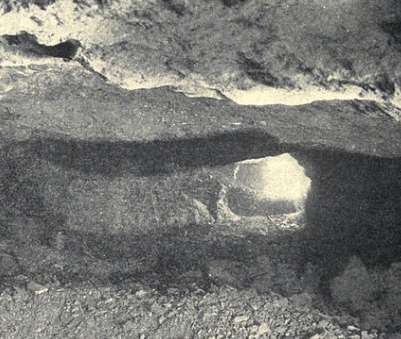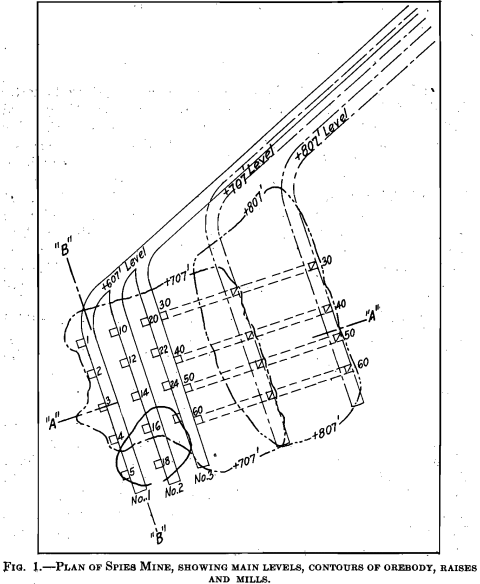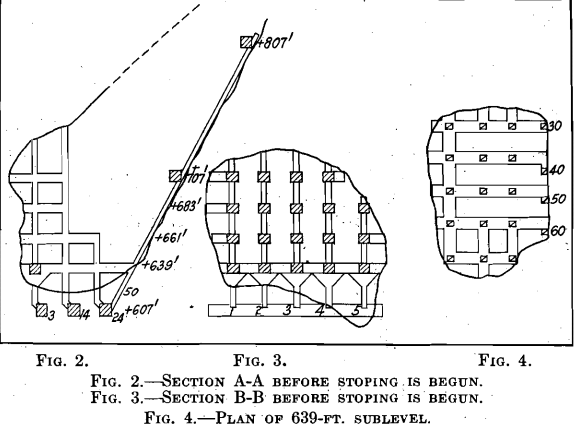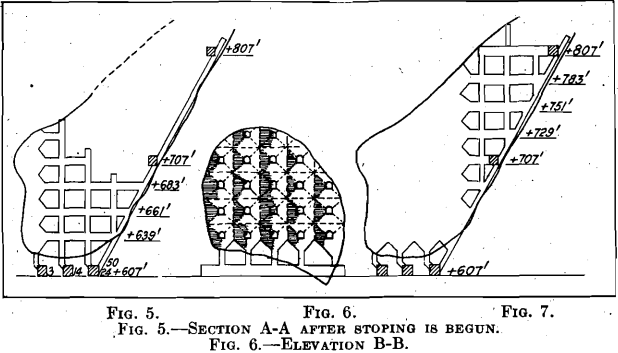Speaking generally, in the Open Stope Mining Method, the jasper hanging walls of most of the deposits in the Iron River district dip at a steep angle and are exceedingly strong, standing without caving, even after mining has been continued for years and after large excavations have been made. The ore is fairly hard and tough and contains no slippage faces. It occurs in large masses, which are often egg shape, with the smaller end down, and can be mined in open stopes without the use of timber. The common system employed in the district is the shrinkage stope, or some modification of it. The Spies system was developed to utilize the advantages of the open-stope method and to avoid the disadvantages of the shrinkage stope.
The Spies shaft was sunk to such a depth that the bottom, or third level, was in rock at a short distance below the bottom of the orebody, the shape and extent of which had been previously determined by diamond drilling. This is shown in plan and by the ore contours at the first, second, and third levels in Fig. 1, and in section in Figs. 2 to 7.
In order to provide the necessary mills and raises, three parallel crosscuts were driven on 25 ft. centers on the bottom level. Drifts on the second and first levels were driven to the orebody and followed the foot wall in a southerly direction to the end of the ore. In crosscut 3, Fig. 1, raises 30, 40, 50, and 60 were carried up on the foot wall and holed into the second level, and were ultimately carried up and holed into the first level. These foot-wall raises carry the pipes and ladders, provide a means of ventilation, and furnish safe communication to all working places in the stope.
From crosscuts 1, 2, and 3, raises were completed to a height of 32 ft., or the elevation of the first sublevel. They were then connected by east and west crosscuts to the main foot-wall raises 30, 40, 50, and 60, shown in Fig. 4. The crosscuts in raises 1 to 5 were then driven west and the hanging wall located. While this work was in progress, raises 1 to 5, 10, 12, 14, 16, 18 were driven until they reached the hanging wall. At intervals of 22 ft., the raises were connected by east and west crosscuts and the hanging wall to the west was located at the elevation of each sublevel. This is shown in Fig. 2.

Below the 639-ft. sublevel raises 1 to 5 were coned to an angle of about 45° to serve as mills. Miners then started in each crosscut on the 639-ft. sublevel, at points near the hanging wall and made fanned-shaped holes toward the same. By repeating this operation on sublevels at higher elevations, the ore was cut away from the hanging wall and a narrow opening existed over the mills in crosscut 1 for the length and height of the orebody. From this time on, to the completion of the stope, the work was straight mining. Miners set up their machines in the various crosscuts at a safe distance from the edge of the open stope and drove fanshaped holes toward the west, care being taken to pull back the east face in a vertical plane.
If one could stand against the hanging wall at a point opposite the center of the stope and look east, this face would resemble, in prospective, a number of pyramid shaped funnels in a horizontal position, the larger end pointing toward the observer, the crosscuts being the spouts. This is shown in section and elevation in Figs. 5 and 6. While stoping is being continued, it is necessary to complete additional raises and to do crosscutting at higher elevations, or in parts of the orebody farther east.
DISADVANTAGES OF THE SHRINKAGE STOPE
- In a shrinkage stope, after mills have been made, the orebody is undercut. By setting up the machines on the broken ore and working around the perimeter of the stope, its height is increased until the top of

the deposit is reached. After each blast, only sufficient ore is drawn from the mills to make room for the miners to work. A safe rule to follow is to have the back above the point where the machines are set up close enough for it to be touched by a miner when his arm is extended. With this precaution, it can be readily trimmed. Further, miners should not be permitted to go out toward the center of the stope, but should be kept close to a solid wall. Observing these rules and always working around the perimeter, causes large orebodies to remain in the center of the stope which either must be blasted, by the use of long drills, or if they cannot be reached they must be left until they become so heavy that they will fall because of their weight. In time, these large masses are drawn down to the mills, when they must be broken by men who enter the mills from the bottom to drill and blast them; this is slow, expensive, and exceedingly dangerous work.

2. As the ore is broken in a shrinkage stope, only about one-third of it can be drawn out of the mills. The pile in the stope must constantly be increased in height until the top of the deposit has been reached and the stope completed. A large investment, represented by two-thirds of the broken ore, is tied up until the stope is completed.
3. The miners spend a large proportion of their time trimming the back, trying to make it safe; their drilling efficiency is, therefore, low.
4. In drawing sufficient ore each day to keep the top of the pile at the proper distance from the back, there is constant danger that the ore will not settle properly and later on will surge and endanger the lives of the men in the stope.
5. If seams or bunches of rock are encountered, they must be broken with the ore; there is no means of separating the material.
6. Ventilation, as a rule, is poor and much time is lost after each blast.
ADVANTAGES OF THE SPIES SYSTEM
These will be compared in the same order as the disadvantages of the shrinkage stope.
- All men are provided with a safe and easy traveling road to their working places. There is every opportunity for miners to drill their holes with a proper burden on them, so that it is unnecessary to break the ore in large masses. It is not necessary to go up into mills to drill and blast. These are the chief factors that make it possible to obtain low cost by the use of this system.
- All of the ore broken each day is drawn from the mills, only enough being left to protect the stoppers from the shock of falling ore blasted in the stope. An accurate check can, therefore, be kept on the miners and high efficiency obtained.
- No time is lost in trimming. The men are in no danger from falls of ground so their time is spent in drilling and blasting; their efficiency is, therefore, much higher than in the shrinkage stope.
- There is no danger that the ore upon which the men are standing will be drawn from under their feet, as they work in crosscuts with solid ore below them. Their machines are set up on posts, which is preferable to using tripods on loose ground.
- During the development work in the sublevels, all seams of rock in the ore are outlined and can be mined before the stope has reached that locality, the rock being dumped into raises that are not being used as mills. It is, therefore, possible to mine the ore and keep it clean.
- On account of the large number of small raises and the connections with upper levels, no trouble is experienced with ventilation. Blasting can be done at any time during the shift and only a few minutes lost. The area of the open stope soon becomes so large that the gases are rapidly dissipated and pass off through the upper levels.
With the exception of a small thickness of ore left above the first level to support the overburden of sand, the stope in the Spies is completed. In this mine, on a comparatively narrow orebody, we have also worked the shrinkage-stope method, and, therefore, have had an opportunity to make a close study and comparison of the two systems. Our records show that the cost of breaking ore was about 4 percent, higher in the shrinkage stope than where the Spies system was used. From every point of view, the Spies system has proved more satisfactory than the shrinkage stope.
